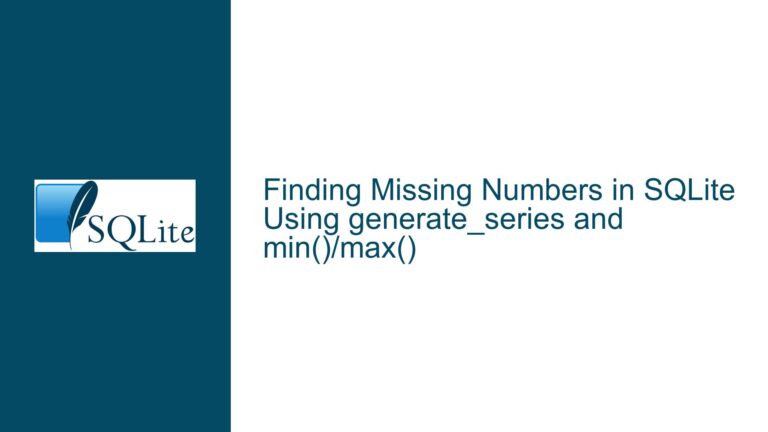Students Excluded by Maximum Grade Threshold in SQLite: Schema and Query Fixes
Foreign Key Mismatches and Incorrect Exclusion Logic in Student-Grade Queries
Issue Overview
The core challenge involves retrieving a list of students who have not achieved any grade equal to or exceeding 2.00 across all subjects. The expected result includes students "Harry Potter" and "Hermione Granger," excluding "Ron Weasley" due to his 2.05 grade in English. The problem arises from two interrelated issues: schema design flaws affecting data integrity and query logic errors that fail to correctly exclude students with grades above the threshold.
The schema defines three tables: students, subjects, and grades. The grades table includes foreign key constraints intended to enforce referential integrity between grades and their corresponding students/subjects. However, these constraints contain typographical errors in the referenced table names (student and subject instead of students and subjects). This mismatch renders the foreign key constraints ineffective, allowing orphaned records if foreign key enforcement is enabled. While the provided sample data does not trigger immediate errors due to SQLite’s default foreign key settings, this oversight compromises long-term data reliability.
The query logic challenge revolves around correctly identifying students with no grades meeting or exceeding 2.00. A naive approach using a simple WHERE grade < 2.00 filter would erroneously include students who have any grade below 2.00, even if other grades exceed the threshold. This necessitates a more sophisticated approach to ensure that all grades for a given student fall below the threshold.
Possible Causes
Incorrect Foreign Key References in Schema
Thegradestable defines foreign keys referencing non-existent tablesstudent(id)andsubject(id)instead of the correctly namedstudents(id)andsubjects(id). SQLite’s foreign key enforcement relies on exact table name matches. This mismatch prevents the database from validating the existence of student and subject records when inserting grades, leading to potential orphaned records if foreign keys are enforced viaPRAGMA foreign_keys = ON;. While the sample data insertion succeeds due to the absence of enforcement by default, this design flaw undermines data integrity in operational scenarios.Misapplication of Filter Conditions in Queries
A common mistake is using a basic filter likeWHERE grade < 2.00without accounting for the possibility of students having some grades below 2.00 and others above it. This approach retrieves students with any grade below the threshold, which does not satisfy the requirement to exclude students with any grade at or above 2.00. The root cause is a misunderstanding of how conditional filters apply to joined datasets: they operate on individual rows, not aggregated student records.Inadequate Use of Joins or Subqueries
Failing to use anti-join patterns (e.g.,NOT EXISTSorLEFT JOIN ... WHERE key IS NULL) or aggregation withHAVINGclauses can lead to incorrect results. For example, joiningstudentsdirectly togradeswith aWHERE grade < 2.00condition would include students with multiple grades where at least one is below 2.00, even if others exceed it. Proper exclusion requires ensuring that no grades for a student meet the exclusion criterion.
Troubleshooting Steps, Solutions & Fixes
Step 1: Correct Schema Foreign Key References
Modify the grades table definition to reference the correct tables (students and subjects):
CREATE TABLE grades(
student_id INTEGER,
subject_id INTEGER,
grade REAL,
UNIQUE(student_id, subject_id),
FOREIGN KEY(student_id) REFERENCES students(id), -- Pluralized table name
FOREIGN KEY(subject_id) REFERENCES subjects(id), -- Pluralized table name
PRIMARY KEY(student_id, subject_id)
);
Impact: Ensures that foreign key constraints are enforced correctly, preventing invalid student/subject IDs in the grades table. If existing tables were created with the incorrect schema, they must be dropped and recreated or altered via ALTER TABLE (though SQLite’s ALTER TABLE capabilities are limited).
Step 2: Use Anti-Join or Aggregation to Exclude Students
To exclude students with any grade ≥ 2.00, use one of the following approaches:
Approach 1: NOT EXISTS Subquery
SELECT s.fname, s.lname
FROM students s
WHERE NOT EXISTS (
SELECT 1
FROM grades g
WHERE g.student_id = s.id
AND g.grade >= 2.00
);
Mechanism: The subquery checks for the existence of at least one grade ≥ 2.00 per student. NOT EXISTS excludes those students from the result set.
Approach 2: LEFT JOIN with Exclusion Check
SELECT s.fname, s.lname
FROM students s
LEFT JOIN grades g
ON s.id = g.student_id
AND g.grade >= 2.00
WHERE g.student_id IS NULL;
Mechanism: The LEFT JOIN attempts to match students with grades ≥ 2.00. The WHERE clause filters for students with no such matches (g.student_id IS NULL).
Approach 3: Aggregation with HAVING Clause
SELECT s.fname, s.lname
FROM students s
JOIN grades g ON s.id = g.student_id
GROUP BY s.id
HAVING MAX(g.grade) < 2.00;
Mechanism: Groups grades by student and filters groups where the maximum grade is below 2.00. This guarantees that all grades for the student are below the threshold.
Step 3: Validate Query Results Against Sample Data
After executing any of the above queries, verify that the results match the expected output:
Harry,Potter
Hermione,Granger
Ron Weasley is excluded due to his 2.05 grade in English. Testing with the provided sample data confirms the correctness of the solution.
Step 4: Address Edge Cases and Performance Considerations
- Students with No Grades: The current queries exclude students with no grades. If such students should be included, modify the
JOINin Approach 3 to aLEFT JOINand handleNULLgrades. - Indexing: For large datasets, ensure indexes exist on
grades(student_id, grade)to optimize subquery and join performance. - Decimal Precision: Use
ROUND()if grades are stored with floating-point imprecision (e.g.,ROUND(grade, 2) >= 2.00).
Final Schema and Query
Combining the corrected schema with Approach 1:
-- Corrected Schema
CREATE TABLE students(
id INTEGER PRIMARY KEY AUTOINCREMENT,
fname VARCHAR(30),
lname VARCHAR(30)
);
CREATE TABLE subjects(
id INTEGER PRIMARY KEY AUTOINCREMENT,
name VARCHAR(30)
);
CREATE TABLE grades(
student_id INTEGER,
subject_id INTEGER,
grade REAL,
UNIQUE(student_id, subject_id),
FOREIGN KEY(student_id) REFERENCES students(id),
FOREIGN KEY(subject_id) REFERENCES subjects(id),
PRIMARY KEY(student_id, subject_id)
);
-- Correct Query
SELECT s.fname, s.lname
FROM students s
WHERE NOT EXISTS (
SELECT 1
FROM grades g
WHERE g.student_id = s.id
AND g.grade >= 2.00
);
This solution ensures both data integrity through proper foreign key constraints and accurate query results through anti-join logic.






